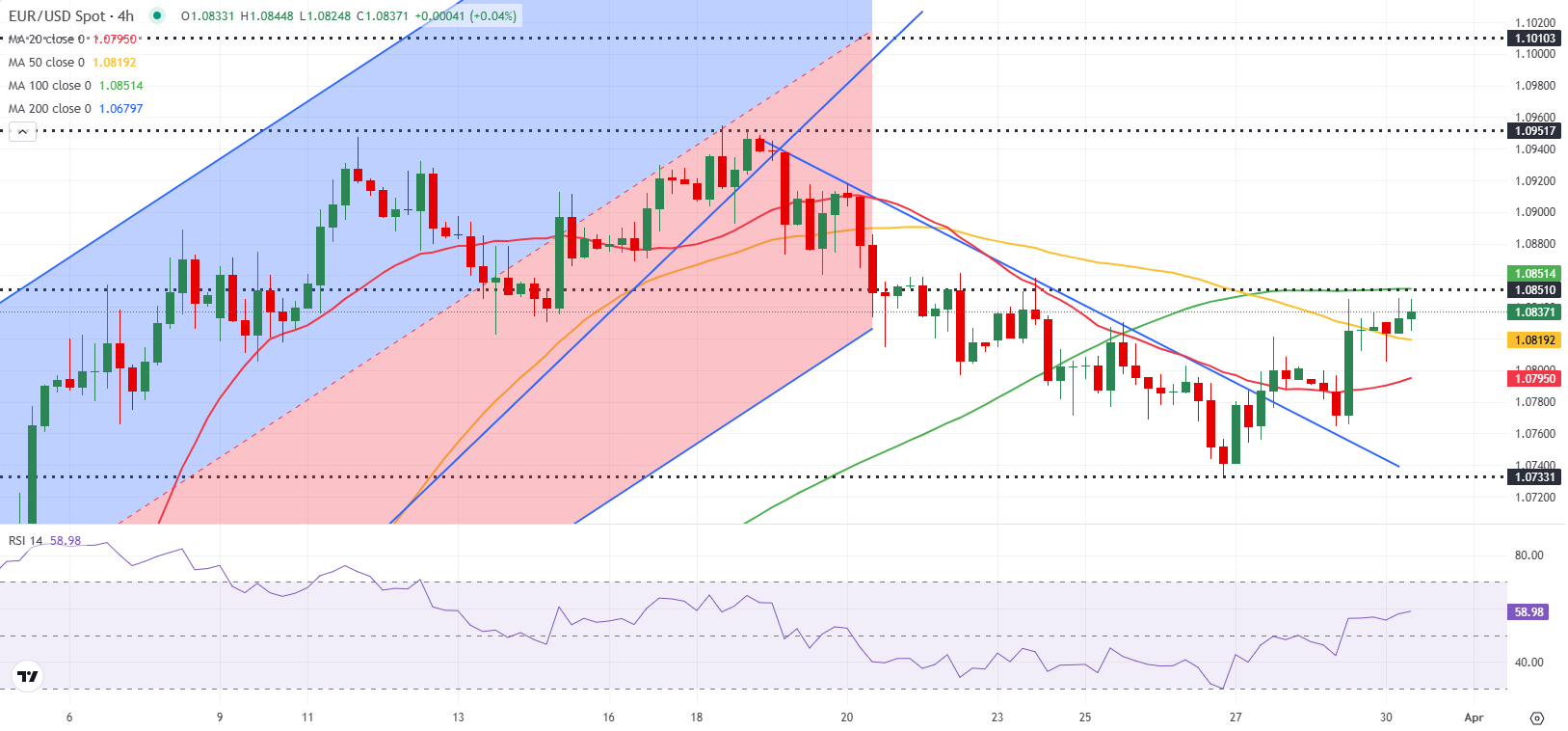- EUR/USD holds comfortably above 1.0800 in the European morning on Monday.
- The US Dollar stays under pressure following latest tariff headlines.
- The technical outlook points to a bullish tilt in the near term.
EUR/USD registered gain on Thursday and Friday to end the previous week virtually unchanged. The pair holds steady above 1.0800 in the European session on Monday. Although the pair's technical outlook points to a bullish bias, the Euro could have a difficult time gathering strength in the risk-averse market atmosphere.
The selling pressure surrounding the US Dollar (USD) helps EUR/USD hold its ground to start the new week as investors grow increasingly concerned about the potential negative impact of tariffs on the US economic outlook.
US Dollar PRICE Today
The table below shows the percentage change of US Dollar (USD) against listed major currencies today. US Dollar was the weakest against the Japanese Yen.
| USD | EUR | GBP | JPY | CAD | AUD | NZD | CHF | |
|---|---|---|---|---|---|---|---|---|
| USD | -0.06% | -0.21% | -0.51% | 0.11% | 0.04% | 0.03% | -0.07% | |
| EUR | 0.06% | -0.05% | -0.42% | 0.21% | 0.18% | 0.13% | 0.04% | |
| GBP | 0.21% | 0.05% | -0.39% | 0.31% | 0.23% | 0.21% | 0.14% | |
| JPY | 0.51% | 0.42% | 0.39% | 0.63% | 0.61% | 0.59% | 0.37% | |
| CAD | -0.11% | -0.21% | -0.31% | -0.63% | -0.04% | -0.08% | -0.17% | |
| AUD | -0.04% | -0.18% | -0.23% | -0.61% | 0.04% | -0.03% | -0.13% | |
| NZD | -0.03% | -0.13% | -0.21% | -0.59% | 0.08% | 0.03% | -0.10% | |
| CHF | 0.07% | -0.04% | -0.14% | -0.37% | 0.17% | 0.13% | 0.10% |
The heat map shows percentage changes of major currencies against each other. The base currency is picked from the left column, while the quote currency is picked from the top row. For example, if you pick the US Dollar from the left column and move along the horizontal line to the Japanese Yen, the percentage change displayed in the box will represent USD (base)/JPY (quote).
Over the weekend, the Wall Street Journal reported that US President Donald Trump's advisers are considering imposing global tariffs of up to 20% on all imports into the US. Additionally, Trump said on Sunday that if he feels that Moscow is trying to block his attempts to end the war in Ukraine, he would impose secondary tariffs of 25%-50% on buyers of Russian oil.
Meanwhile, European Central Bank (ECB) President Christina Lagarde said on Monday that Trump's tariff policy would lower Eurozone growth by at least 0.3%. According to Reuters, Goldman Sachs announced earlier in the day that they are now expecting the ECB to deliver 25 basis points (bps) rate cuts in April, June and July.
The economic calendar will feature preliminary March Consumer Price Index (CPI) data from Germany on Monday. Investors could ignore this report and refrain from taking large positions before the Trump administration shares the details of the new tariff agenda on Wednesday.
EUR/USD Technical Analysis

The Relative Strength Index (RSI) indicator on the 4-hour chart rises toward 60 early Monday, reflecting a bullish stance. Additionally, EUR/USD continues to pull away from the 200-day Simple Moving Average (SMA) after testing this level twice in the previous week.
On the upside, 1.0850 (static level, 100-period SMA) aligns as first resistance before 1.0900 (static level, round level) and 1.0950 (static level). Looking south, interim support could be spotted at 1.0830 (20-day SMA) before 1.0800 (static level, round level) and 1.0730 (200-day SMA).
Tariffs FAQs
Tariffs are customs duties levied on certain merchandise imports or a category of products. Tariffs are designed to help local producers and manufacturers be more competitive in the market by providing a price advantage over similar goods that can be imported. Tariffs are widely used as tools of protectionism, along with trade barriers and import quotas.
Although tariffs and taxes both generate government revenue to fund public goods and services, they have several distinctions. Tariffs are prepaid at the port of entry, while taxes are paid at the time of purchase. Taxes are imposed on individual taxpayers and businesses, while tariffs are paid by importers.
There are two schools of thought among economists regarding the usage of tariffs. While some argue that tariffs are necessary to protect domestic industries and address trade imbalances, others see them as a harmful tool that could potentially drive prices higher over the long term and lead to a damaging trade war by encouraging tit-for-tat tariffs.
During the run-up to the presidential election in November 2024, Donald Trump made it clear that he intends to use tariffs to support the US economy and American producers. In 2024, Mexico, China and Canada accounted for 42% of total US imports. In this period, Mexico stood out as the top exporter with $466.6 billion, according to the US Census Bureau. Hence, Trump wants to focus on these three nations when imposing tariffs. He also plans to use the revenue generated through tariffs to lower personal income taxes.
Information on these pages contains forward-looking statements that involve risks and uncertainties. Markets and instruments profiled on this page are for informational purposes only and should not in any way come across as a recommendation to buy or sell in these assets. You should do your own thorough research before making any investment decisions. FXStreet does not in any way guarantee that this information is free from mistakes, errors, or material misstatements. It also does not guarantee that this information is of a timely nature. Investing in Open Markets involves a great deal of risk, including the loss of all or a portion of your investment, as well as emotional distress. All risks, losses and costs associated with investing, including total loss of principal, are your responsibility. The views and opinions expressed in this article are those of the authors and do not necessarily reflect the official policy or position of FXStreet nor its advertisers. The author will not be held responsible for information that is found at the end of links posted on this page.
If not otherwise explicitly mentioned in the body of the article, at the time of writing, the author has no position in any stock mentioned in this article and no business relationship with any company mentioned. The author has not received compensation for writing this article, other than from FXStreet.
FXStreet and the author do not provide personalized recommendations. The author makes no representations as to the accuracy, completeness, or suitability of this information. FXStreet and the author will not be liable for any errors, omissions or any losses, injuries or damages arising from this information and its display or use. Errors and omissions excepted.
The author and FXStreet are not registered investment advisors and nothing in this article is intended to be investment advice.
Recommended Content
Editors’ Picks

USD/JPY slumps to three-week low amid Trump's tariffs-inspired risk-off impulse
USD/JPY dives to a three-week low, closing in on 147.00 in the Asian session on Thursday as Trump's sweeping trade tariffs provide a strong boost to the safe-haven asset Japanese Yen. Meanwhile, US receesion fears smash the US Dollar back closer to a multi-month low touched in March, undermining the pair.

AUD/USD remains heavy below 0.6300 despite upbeat Chinese PMI data
AUD/USD remains under decent selling pressure below 0.6300 in Asian session on Thursday. The Australian Dollar keeps losses against the US Dollar despite the strong Chinese PMI data. US President Donald Trump's global reciprocal tariffs-led risk aversion remains a drag on the Aussie pair.

Gold price corrects from record high as focus shifts to US NFP data
Gold price is correcting sharply from a new record high of $3,168 reached in the early Asian session on Thursday. Despite the pullback, Gold price preserves a significant part of the recent record run, courtesy of escalating risks of a global trade war and a US recession.

Bitcoin and top altcoins slide as Trump kicks off reciprocal tariffs
Bitcoin and the entire crypto market saw a quick correction on Wednesday following President Donald Trump's reciprocal tariff announcements based on half of each country's respective rates.

Trump’s “Liberation Day” tariffs on the way
United States (US) President Donald Trump’s self-styled “Liberation Day” has finally arrived. After four straight failures to kick off Donald Trump’s “day one” tariffs that were supposed to be implemented when President Trump assumed office 72 days ago, Trump’s team is slated to finally unveil a sweeping, lopsided package of “reciprocal” tariffs.

The Best brokers to trade EUR/USD
SPONSORED Discover the top brokers for trading EUR/USD in 2025. Our list features brokers with competitive spreads, fast execution, and powerful platforms. Whether you're a beginner or an expert, find the right partner to navigate the dynamic Forex market.